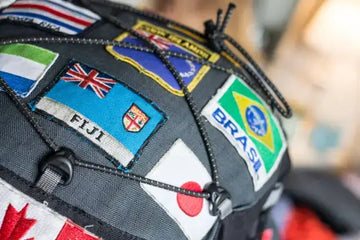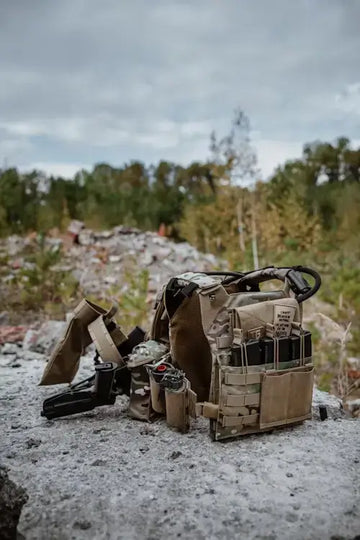
Adding patches to your tactical backpack is a simple way to express yourself, show affiliations, or add useful features.
Whether you’re in the military, law enforcement, or simply an outdoor enthusiast, patches can make your gear more personalized and practical.
With so many attachment methods available, it’s helpful to know the differences so you can pick the best option.
Here’s a breakdown of the main types of tactical backpack patches, focusing on how they attach and what makes each type unique.
1. Hook-and-Loop (Velcro) Patches
Hook-and-loop patches, often called Velcro patches, are one of the most popular options for tactical backpacks.
They are highly versatile and easy to use, allowing you to swap patches in seconds.
How Hook-and-Loop Patches Work
These patches use a hook-and-loop system, with one side covered in tiny hooks and the other in soft loops.
Most tactical backpacks come with loop panels that allow easy attachment for Velcro-backed patches.
Pros of Hook-and-Loop Patches
- Quick Attachment: Hook-and-loop patches attach instantly, letting you swap or rearrange patches whenever you want.
- Great for Customization: Ideal for those who like to change up their patches for different occasions, such as special events, missions, or moods.
- Non-Damaging to the Backpack: Since these patches don’t involve sewing or adhesive, they don’t leave marks or residue.
Cons of Hook-and-Loop Patches
- Wear and Tear Over Time: With frequent use, the hook-and-loop grip may weaken, especially if exposed to dust or rough handling.
- May Stick Out: Some people find that hook-and-loop patches are a bit bulkier than other types, affecting the overall look of the backpack.
- Requires a Velcro Panel: Not all backpacks come with a Velcro panel, so you may need to add one to use these patches.
Shop our tactical backpack comes with 5 special patches.

2. Sew-On Patches
Sew-on patches are a classic choice for those looking for a permanent attachment.
They’re ideal for patches you want to keep on your tactical backpack long-term, such as a name tag, flag, or other identifiers.
How Sew-On Patches Work
Sew-on patches are stitched directly onto the backpack’s fabric, either by hand or with a sewing machine.
This method creates a durable bond that withstands wear and tear exceptionally well.
Pros of Sew-On Patches
- Long-Lasting Durability: Sew-on patches are highly secure and hold up through heavy use, frequent washing, and harsh conditions.
- Sleek Appearance: These patches lay flat against the fabric, giving a clean and streamlined look without extra bulk.
- Perfect for Permanent Attachment: Ideal for patches that you don’t plan to remove, making them a great choice for logos or emblems.

Cons of Sew-On Patches
- Takes Time and Effort: Sewing requires a bit of skill and patience, so it’s not as quick as other methods. You might even need professional help if you want a flawless finish.
- Permanent: Once sewn, removing the patch is challenging and may leave holes or marks, so sew-on patches are best for items you plan to keep on your backpack permanently.
- Limited Flexibility: Unlike Velcro, sew-on patches are fixed, so you can’t easily change or remove them.
3. Iron-On Patches
Iron-on patches are popular for people looking for a semi-permanent solution without sewing.
These patches come with a heat-activated adhesive that sticks to the fabric when pressed with an iron.
How Iron-On Patches Work
To apply an iron-on patch, place it on the desired spot, cover it with a cloth, and press down with a hot iron for several seconds.
The heat activates the adhesive, bonding the patch to the fabric.
Pros of Iron-On Patches
- Quick and Convenient: Iron-on patches are faster to apply than sew-on patches and require minimal effort.
- Smooth, Flat Look: Like sew-on patches, iron-on patches lie flat on the backpack, offering a neat appearance.
- Semi-Permanent Hold: Iron-on patches provide a strong bond without stitching, ideal for patches you don’t plan to move often.
Cons of Iron-On Patches
- Not as Durable in Harsh Conditions: Iron-on patches are less reliable in extreme environments, as the adhesive can weaken with exposure to water or heat.
- Limited Fabric Compatibility: Iron-on patches work best on certain fabrics like cotton but may not stick well to nylon or polyester, which are common in tactical backpacks.
- Hard to Remove: Removing iron-on patches can damage the fabric or leave adhesive residue, so they’re best for semi-permanent use.
4. PVC (Rubber) Patches
PVC (Polyvinyl Chloride) patches are made from soft rubber, giving them a 3D effect and a rugged feel.
They’re waterproof and resistant to fading, which makes them perfect for outdoor use.
How PVC Patches Work
Most PVC patches come with a Velcro backing for easy attachment and removal, making them convenient for tactical backpacks that already have a Velcro panel.
Pros of PVC Patches
- Waterproof and Weather-Resistant: PVC patches don’t absorb water, so they’re ideal for wet environments or rainy conditions.
- Unique 3D Look: PVC patches have a raised, rubbery appearance that sets them apart from fabric patches.
- Easy to Clean: Dirt and debris can be wiped off easily, keeping them looking new for longer.
Cons of PVC Patches
- Less Flexible: PVC patches are thicker and stiffer than fabric options, which may feel heavier on certain parts of the backpack.
- Mostly Velcro Only: Limited to Velcro attachment, so you’ll need a loop panel to attach PVC patches to your tactical backpack.
5. Adhesive (Stick-On) Patches
Adhesive patches, also known as stick-on patches, are less common in the tactical gear world but can be useful for temporary purposes.
They attach to the backpack fabric with a pressure-sensitive adhesive, sticking on without any additional tools.
How Adhesive Patches Work
Adhesive patches stick directly to the fabric when pressed firmly. While quick to apply, they are generally not as long-lasting as other types.
Pros of Adhesive Patches
- Fast and Simple: They require no tools or sewing, making them convenient for fast attachment.
- Good for Temporary Use: Adhesive patches are best for short-term use or events where you don’t need a permanent attachment.
Cons of Adhesive Patches
- Least Durable: The adhesive wears out quickly, especially in wet or rough environments.
- Leaves Residue: Removing adhesive patches can leave sticky residue on the fabric, which may require extra cleaning.
6. Embroidered Patches
Embroidered patches are a style rather than an attachment method, but they are worth noting for their quality, appearance and popularity in tactical gear.
How Embroidered Patches Work
Embroidered patches can be applied through various methods, including sewing, hook-and-loop, or iron-on.
They’re created by stitching threads onto a fabric base, resulting in a raised, colorful design.
Pros of Embroidered Patches
- Attractive, High-Quality Look: Embroidered patches add a premium look with their raised, textured design.
- Available Across Attachment Types: You can find embroidered patches in Velcro, sew-on, or iron-on, making them versatile.
- Durable: Made with tough thread and fabric, embroidered patches tend to last a long time and withstand frequent use.
Cons of Embroidered Patches
- Bulky: The thickness of the embroidery can make the patch stick out, which may not be ideal for every application.
- Higher Cost: Due to the stitching involved, embroidered patches are often more expensive than standard printed patches.
Conclusion: Choosing the Right Patches for Tactical Backpacks
When it comes to customizing your tactical backpack with patches, it depends on your needs, preferences, and intended use.
Here’s a quick summary to help guide your decision:
- Hook-and-Loop (Velcro): Best for frequent changes and versatility.
- Sew-On: Great for permanent patches that need to withstand wear.
- Iron-On: Good for semi-permanent use without sewing.
- Embroidered: Adds a quality look in various attachment types.
- PVC (Rubber): Ideal for tough, wet environments, often with Velcro backing.
- Adhesive: Suitable for short-term use but less durable.
All these tactical backpack patches have their unique benefits, so think about how you’ll use the patches, how often you want to switch them, and the durability you need. With the right choice, you can personalize your tactical backpack to be both functional and stylish.
If you need custom tactical patches, please feel free to contact us.





